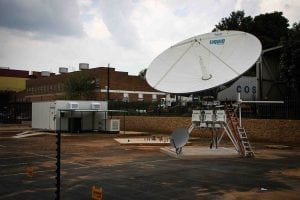Latest News
[Via Satellite 03-07-2014] Liquid Telecom — builder of the largest fiber network in Africa — recently moved to expand its satellite operations in South Africa. The company’s goal is to provide a strong hybrid terrestrial-satellite communications network in order to reach as much of the continent as possible. Scott Mumford, head of satellite services at Liquid Telecom, explained that the growth of fiber across Africa has actually driven up the need for more satellite services.
“Satellite as a whole business, both across Africa outside of Liquid, but also within Liquid, is growing year-on-year, and we are finding that the more fiber is laid, the more demand there is for satellite,” Mumford told Via Satellite. “I can’t think of a country within Africa that would not benefit from the satellite connectivity element of the telco market.”
Liquid Telecom has recently become the first operator to build a satellite hub at Teraco’s South Africa-based Earth Station. This addition complements the company’s expansive fiber network, which stretches more than 17,000 kilometers from Cape Town to Uganda. The size of the African continent makes laying down fiber a lengthy process, especially for last mile activity. As urban areas evolve, population movements are carrying the need for connectivity to less crowded places.
“The main metropolitan areas — the business centers and the capital cities — have had fiber laid into them and the rings put around them,” explained Mumford. “They are becoming more connected on fiber, however what we are finding is that a lot of the workers, much the same as Europe and the U.S., live outside those cities. Digging fiber out to those residential areas and putting fiber into each house takes a lot of time and is very expensive.”
Businesses are also spreading out beyond the reach of fiber. Mumford mentioned that several enterprises have smaller teams located away from metropolitan areas that still require the same connectivity. Furthermore the demand for international traffic and services such as YouTube, Google and Facebook is on the rise. The bulk of Liquid Telecom’s subsea cable capacity comes to South Africa for European and U.S. Web traffic.
“We chose South Africa predominantly because our highest number of subsea routes come in here,” said Mumford. “Also because of the large commercial organizations are run out of South Africa for Trans-African content. It was a strategic decision to host it at one of our core parks that gave us access to our fiber networks going through Central Africa and other countries.”
Adding satellite has increased the availability of Virtual Private Network (VPN) and Multiprotocol Label Switching (MPLS) for businesses and consumers across Eastern, Central and Southern Africa. In Africa, mining sites and safaris are often located well away from terrestrial connectivity solutions. Mines can be hundreds of miles away from main fiber routes, and the cost of laying down that much cable renders most projects commercially unviable. Safaris, in addition to be distant, are also unwelcome for fiber due to wildlife concerns. Not only does the construction to cause ecologic harm, froward animals pose a threat to personnel. But both of these settings demand connectivity, and for safaris especially satellite has become a vital part of sustaining business.
“Tourists go there with iPads, iPods, MacBook’s; most of them want connectivity to two or three devices,” said Mumford. “That can use quite a lot of bandwidth. More people want to share photos on Facebook and Instagram, which requires giving connectivity to these locations … and people want to pay for things with their credit cards, which means they need to be connected.”
As a provider of both terrestrial and satellite solutions, Liquid Telecom is positioned to profit from either means of connectivity. Through a partnership with Newtec, the company is able to provide the products and features needed to bring its new satellite service to market. Liquid Telecom has purchased capacity from ViaSat and Eutelsat, and may look to expand or lengthen contracts in the future.
“Liquid being able to provide both gives us a unique opportunity to be able to say to people: if you want fiber that’s fine. It may take six months, but we can provide satellite temporarily and then switch them over seamlessly,” said Mumford. “We don’t say come back and speak to us in six months. Most people are not prepared to wait that long. They will go to another service provider.”
Get the latest Via Satellite news!
Subscribe Now